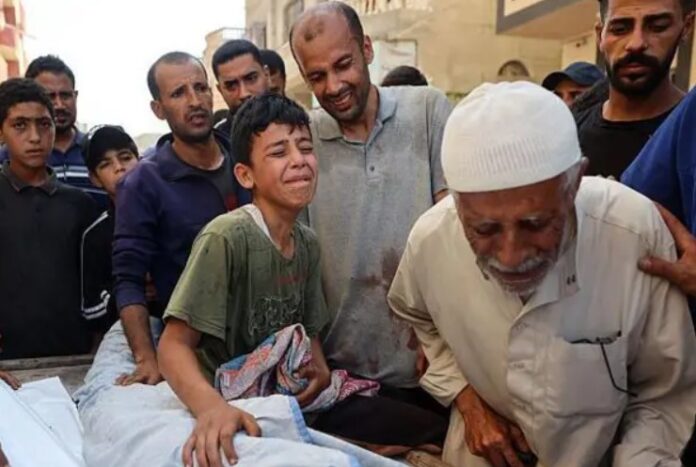Al-Nuseirat Refugee Camp, Gaza — In the early hours of Sunday, a quiet queue for clean water ended in chaos and carnage. Ten Palestinians, six of them children, were killed while waiting to fill jerry cans from a water tanker in central Gaza, following what Israeli officials called a “technical error” during an airstrike aimed at an alleged militant target nearby.
The missile fell just metres from the intended site, striking civilians in one of Gaza’s most vulnerable areas. In the aftermath, verified video footage captured scenes of devastation: children bleeding on the roadside, yellow water containers scattered amid broken bodies, and neighbours crying out for help.
This was not an isolated event. On the same day, 19 more Palestinians were killed in separate strikes on homes in Gaza City and central Gaza. Medical staff at al-Awda Hospital treated dozens of injured civilians, many of them children.
The Collapse of Essentials: A Humanitarian Catastrophe
This tragedy underscores the dire state of Gaza’s collapsing infrastructure. After nine months of war, more than 90% of homes are damaged, and critical services such as water, healthcare, sanitation, are nearing full collapse. For the two million people still trapped in the enclave, the search for water or food now comes with the risk of being killed.
The International Committee of the Red Cross (ICRC) revealed this week that its field hospital in Rafah has treated over 3,400 patients since May, with more than 250 deaths, surpassing its previous yearly total. Most were gunshot victims, wounded while attempting to access basic aid or food rations.
Yet even in death, facts remain disputed. Israel claims it aims to minimise civilian harm, while humanitarian agencies such as the UN report over 789 aid-related deaths, many near US and Israeli-backed food distribution points. The Gaza Humanitarian Foundation (GHF) disputes these figures, branding them “misleading”, though it acknowledges proximity-based risks.
Water as a Weapon: Climate and Conflict Intersect
What makes Sunday’s strike even more tragic is what the victims were doing – fetching water. In a region where clean water is already a scarce and politicised resource, attacks at water points signal a deeper emergency.
Gaza’s water crisis predates this war. Climate change, over-extraction of groundwater, and the blockade’s limits on desalination and repair infrastructure have created one of the world’s most water-insecure zones. Rising temperatures and seawater intrusion are steadily poisoning the aquifer that supports Gaza.
Now, as fuel shortages cripple sewage systems and desalination plants, clean water has become both a survival need and a deadly risk. The UN says that this week’s rare fuel delivery, 75,000 litres is “far from enough” to maintain essential services. Without power, hospitals cannot operate, sanitation breaks down, and diseases like cholera become imminent threats.
Gaza’s Future and a Global Reckoning
This is not just a story of war. It is a warning. Gaza stands at the intersection of armed conflict and climate collapse, a convergence that will increasingly define humanitarian disasters in the 21st century.
What happened in al-Nuseirat, children dying for water, is a glimpse into the future unless the international community wakes up to the compound crises facing conflict zones. Aid alone is not enough. We need a paradigm shift in how we treat environmental security as a peace-building priority.
Until then, Gaza’s residents remain caught in an ever-narrowing space between humanitarian neglect, military escalation, and ecological breakdown.




